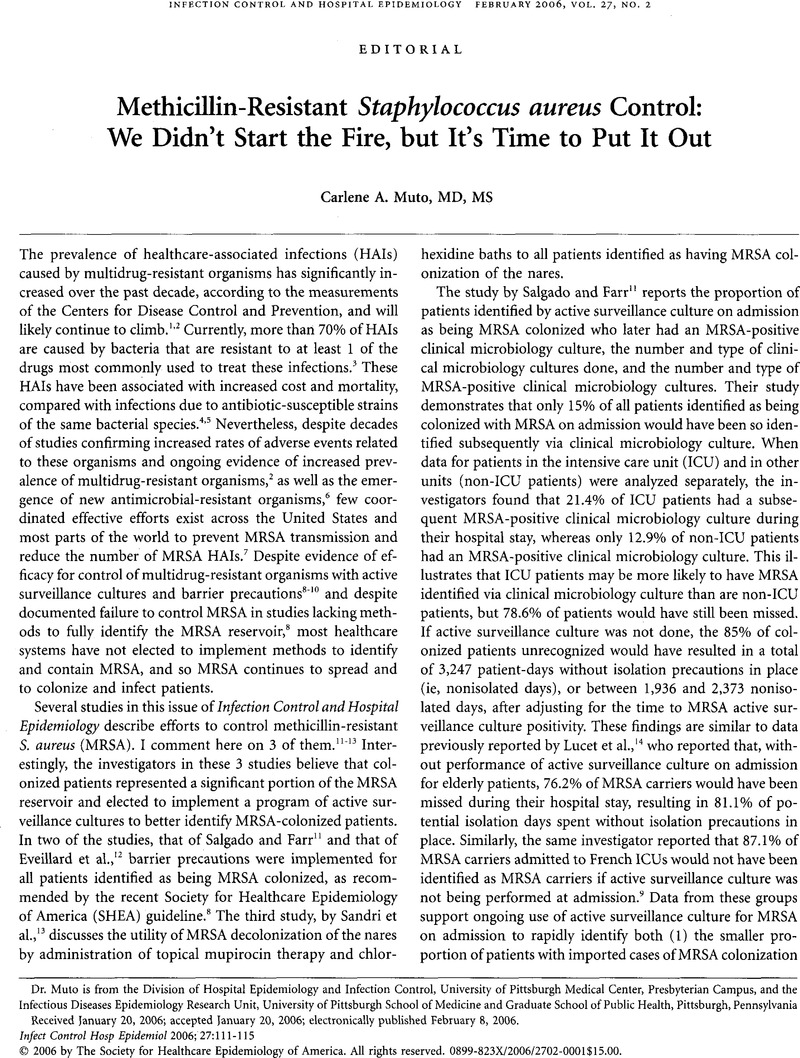Crossref Citations
This article has been cited by the following publications. This list is generated based on data provided by Crossref.
Craven, Donald E.
2006.
Preventing Ventilator-Associated Pneumonia in Adults.
Chest,
Vol. 130,
Issue. 1,
p.
251.
Harrington, Glenys
Watson, Kerrie
Bailey, Michael
Land, Gillian
Borrell, Susan
Houston, Leanne
Kehoe, Rosaleen
Bass, Pauline
Cockroft, Emma
Marshall, Caroline
Mijch, Anne
and
Spelman, Denis
2007.
Reduction in Hospitalwide Incidence of Infection or Colonization with Methicillin-ResistantStaphylococcus aureusWith Use of Antimicrobial Hand-Hygiene Gel and Statistical Process Control Charts.
Infection Control & Hospital Epidemiology,
Vol. 28,
Issue. 7,
p.
837.
Andersen, Bjørg Marit
Rasch, Mette
and
Syversen, Gaute
2007.
Is an increase of MRSA in Oslo, Norway, associated with changed infection control policy?.
Journal of Infection,
Vol. 55,
Issue. 6,
p.
531.
Weinstein, R. A.
Diekema, D. J.
and
Edmond, M. B.
2007.
Look before You Leap: Active Surveillance for Multidrug-Resistant Organisms.
Clinical Infectious Diseases,
Vol. 44,
Issue. 8,
p.
1101.
2007.
Empfehlung zur Prävention nosokomialer Infektionen bei neonatologischen Intensivpflegepatienten mit einem Geburtsgewicht unter 1500 g.
Bundesgesundheitsblatt - Gesundheitsforschung - Gesundheitsschutz,
Vol. 50,
Issue. 10,
p.
1265.
Cimolai, Nevio
2008.
The role of healthcare personnel in the maintenance and spread of methicillin-resistant Staphylococcus aureus.
Journal of Infection and Public Health,
Vol. 1,
Issue. 2,
p.
78.
Peterson, Jess F.
Riebe, Katherine M.
Hall, Gerri S.
Wilson, Deborah
Whittier, Susan
Palavecino, Elizabeth
and
Ledeboer, Nathan A.
2010.
Spectra MRSA, a New Chromogenic Agar Medium To Screen for Methicillin-ResistantStaphylococcus aureus.
Journal of Clinical Microbiology,
Vol. 48,
Issue. 1,
p.
215.
Chroneou, Alexandra
Zias, Nikolaos
Gray, Anthony
Gray, Anthony
Craven, Donald E.
and
Craven, Donald E.
2010.
Surgical Intensive Care Medicine.
p.
325.
Dulon, Madeleine
Haamann, Frank
Peters, Claudia
Schablon, Anja
and
Nienhaus, Albert
2011.
MRSA prevalence in european healthcare settings: a review.
BMC Infectious Diseases,
Vol. 11,
Issue. 1,
Cooper, Tracey
and
Percival, Steven L.
2014.
Biofilms in Infection Prevention and Control.
p.
3.
Hudcova, Jana
Craven, Kathleen A.
and
Craven, Donald E.
2016.
Surgical Intensive Care Medicine.
p.
407.
Nieder, Rolf
Benbi, Dinesh K.
and
Reichl, Franz X.
2018.
Soil Components and Human Health.
p.
659.


